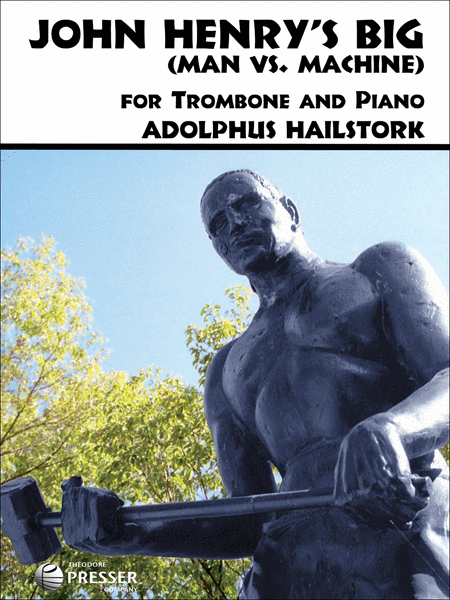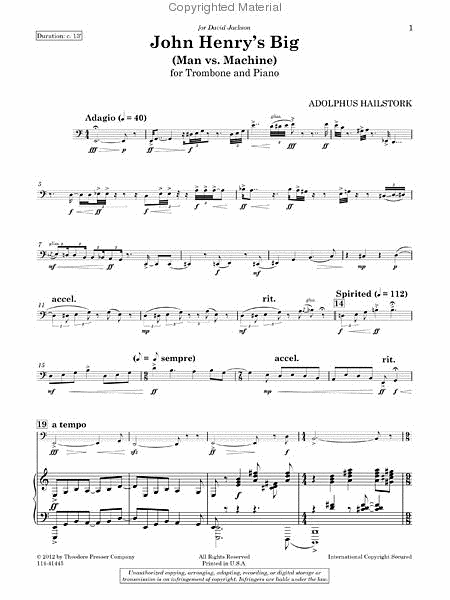John Henry's Big
Man vs. Machine
-
Ships in 1 to 2 weeks
Details
Description
SKU: PR.114414450
Man vs. Machine. Composed by Adolphus Hailstork. Sws. Folk. Set of Score and Parts. With Standard notation. Composed 2009. 24+8 pages. Duration 12 minutes. Theodore Presser Company #114-41445. Published by Theodore Presser Company (PR.114414450).ISBN 9781598064087. UPC: 680160597635. 9x12 inches.
Inspired by the tale of a legendary folk hero, Adolphus Hailstork’s tour-de-force for trombone and piano is a riveting portrayal of the steely strength and stamina of John Henry, a former slave who helped build the American railroads and ultimately outperformed a steam engine. This composition uses quotes from the spiritual Every Time I Feel the Spirit and the folk song The Ballad of John Henry. For advanced players. Duration: 13’__________________________________________Text on the scanned back cover:JOHN HENRY'S BIG(MAN vs. MACHINE)FOR TROMBONE AND PIANOInspired by the tale of the legendary hero, Adolphus Hailstork’s tour-de-force for trombone and piano is a riveting portrayal of the steely strength and stamina of John Henry, a former slave who helped build the American railroads and ultimately outperformed a steam engine.
PROGRAM NOTES by the ComposerJohn Henry was born a slave in the 1840’s or 1850’s. It is important to remember that no one knows for sure if John Henry existed or is a tall tale created by writers. That is one of the things that makes the legend so intriguing.According to the legend, he grew to stand 6 feet tall, 200 pounds – a giant in that day.Though the story of John Henry sounds like the quintessential tall tale, it is certainly based, at least in part, on historical circumstance. There are disputes as to where the legend originates. Some place John Henry in West Virginia, while recent research suggests Alabama. Still, all share a similar back-story.In order to construct the railroads, companies hired thousands of men to smooth out terrain and cut through obstacles that stood in the way of the proposed tracks. One such chore that figures heavily into some of the earliest John Henry ballads is the blasting of the Big Bend Tunnel, more than a mile straight through a mountain in West Virginia.Steel-drivin’ men like John Henry used large hammers and stakes to pound holes into the rock, which were were then filled with explosives that would blast a cavity deeper and deeper into the mountain. In the folk ballads, the central event took place under such conditions. Eager to reduce costs and speed up progress, some tunnel engineers were using steam drills to power their way into the rock. According to the great American tall tales, on hearing of the machine, John Henry challenged the steam drill to a contest. He won, but died of exhaustion, his life cut short by his own superhuman effort.This composition uses quotes from the spiritual Every Time I Feel the Spirit and the folk song The Ballad of John Henry.JOHN HENRY’S BIG was composed for trombonist David Jackson.


 Share
Share